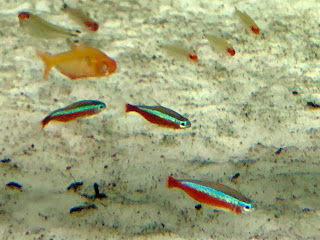 |
| The River Eske, Donegal Town |
A few weeks ago, my wish came true. My husband Jeff and I flew to Dublin for a self-guided bike tour around the Donegal peninsula. After arriving in Dublin, we traveled by bus for three hours through the green Irish countryside to Donegal Town. There, we met up with our Seattle friends Tom and Linda McElroy. That afternoon, Seamus from Ireland by Bike (http://irelandbybike.com) came to our bed and breakfast and fitted us to four hybrid bikes. He gave us GPS systems, maps and route notes and the names of each of the Bed and Breakfast Inn he had booked for us. The next morning we rode west along the Irish Sea. Each day the four of us explored the ancient landscape following the route Seamus gave us. We cycled from village to village while Seamus ferried our suitcases. The following poem and pictures describe our wonderful trip.
Donegal by Bike
 |
| Killybegs Harbor |
Biking west along the sea.
In front was Jeff with GPS
Behind Linda, Tom and me.
We cycled round the northwest coast,
Killybegs, then Glencolumbkille,
Through Glenties, Ardara and Annagry,
Fueled by Guinness and cups of tea.
Each day, the hills had steeper pitch
Rain and fog obscured the view.
When woolly sheep got on the road
There’s no room for bicycles too.
When woolly sheep got on the road
There’s no room for bicycles too.
The wind blew rain across my specs.
Linda’s legs were smeared with grease.We cycled on; our spirits strong.
Fuchsia cliffs put us at peace.
 |
| The Irish Sea estuary west of Ardara |
 |
| Glengesh Valley |
The road rose into the mist
Wet and tired; we crossed the divide
To a valley the gods had kissed.
Waterfalls bubbled down the rocks
The valley walls were gold and green
We coasted past, to our eyes delight,
The prettiest bay we’d ever seen.
We sat on wooden benches
Eating salmon with buttered brown bread.
Bananas, apples and KitKat bars
Kept all of us well fed.
At night, we hit the local pubs
Tom made friends with everyone.
We followed him, an easy task.
Donegal folk are full of fun.
 |
| A leprechaun's hidden gold! |
 |
| Waterfalls everywhere |
Last day was up to the top of the world
 |
| The long push up Glenveagh Valley |
Past Errigal and down to Glenveagh.
We skidded up the boulder track
Pushing heavy bikes half the way.
From the top of Glenveagh Valley
We cruised down to Letterkenny
Through flower and cow-filled pastures
We etched memories aplenty.
What a wonderful way to get to know
The faery lands of green Eireann.
Maybe I’ll return next year
And do it all again.
Needless to say our trip was memorable. The weather did have its moments, blustering winds, morning mists and the occasional rainstorm mixed with threatening clouds and sunny skies! In short, it reminded me of my home in the Pacific Northwest. I am proud to say that my persistent exercising gave me the ability to cycle Donegal's rugged terrain. I am equally proud that my husband and our friends Tom and Linda were capable also. How much fun it is to have the fitness for such a trip at any time in life, but especially when the four of us are in our sixties and seventies. In truth, we've all been diligent about exercising on a regular basis as we've aged. In my case that has meant five years of regular circuit training, often 4 to 5 times a week combined with endless walks, hikes and bike rides. I think the secret to being physically capable as you age is to keep moving and throw a little weight training in there too. If you exercise on a regular basis, the rewards can be great. Not only was I able to cycle this glorious trip, I have no lower back pain and my knees are stronger than they were five years ago. The thrill of coasting down the Glengesh Valley, past bubbling creeks and endless waterfalls, along a glorious estuary and past hedgerows of red fuchsias is exhilarating. Top it off with a pint of Guinness, well, it's a wonderful thing. Thank you Seamus and Nora for sharing your green corner of the world with us. And thanks Jeff, Tom and Linda for being such great companions. It was a blast!
 |
| Linda and I try out an ancient grave for size |



























